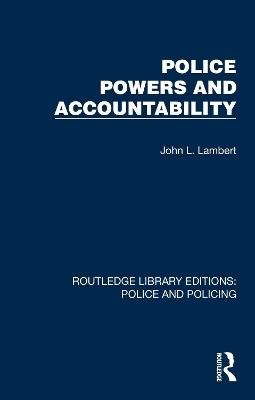
Police Powers and Accountability
Seiten
2025
Routledge (Verlag)
978-1-032-41905-3 (ISBN)
Routledge (Verlag)
978-1-032-41905-3 (ISBN)
- Noch nicht erschienen (ca. März 2025)
- Versandkostenfrei innerhalb Deutschlands
- Auch auf Rechnung
- Verfügbarkeit in der Filiale vor Ort prüfen
- Artikel merken
The traditional view of the role of the police had come under increasing attacks in the early 1980s. The riots of 1981 and the Scarman Inquiry stimulated a widespread public debate about policing, police powers and accountability. Originally published in 1986, this book considers these critical issues in contemporary policing.
The traditional view of the role of the police had come under increasing attacks in the early 1980s. The riots of 1981 and the Scarman Inquiry stimulated a widespread public debate about policing, police powers and accountability. It had become clear that the police did not simply enforce the law. They also made policy about what law to enforce, when to enforce it and against whom to enforce it. It was the control of this discretionary power which was at the heart of the debate at the time.
Originally published in 1986, this book considers these critical issues in contemporary policing. It concentrates on those aspects of policing that were usually covered in law and law related courses. It deals with the constitutional framework within which the police operates. It examines the police complaints procedure and the full range of police powers against the background of the political debate at the time. Throughout the book the 1984 Police and Criminal Evidence Act is discussed in detail and its impact upon police and public alike is analysed.
The traditional view of the role of the police had come under increasing attacks in the early 1980s. The riots of 1981 and the Scarman Inquiry stimulated a widespread public debate about policing, police powers and accountability. It had become clear that the police did not simply enforce the law. They also made policy about what law to enforce, when to enforce it and against whom to enforce it. It was the control of this discretionary power which was at the heart of the debate at the time.
Originally published in 1986, this book considers these critical issues in contemporary policing. It concentrates on those aspects of policing that were usually covered in law and law related courses. It deals with the constitutional framework within which the police operates. It examines the police complaints procedure and the full range of police powers against the background of the political debate at the time. Throughout the book the 1984 Police and Criminal Evidence Act is discussed in detail and its impact upon police and public alike is analysed.
Table of Cases. Table of Statutes. Preface. 1. The Policing Debate 2. The Accountability of the Police 3. The Police Complaints Procedure 4. Arrest and Detention 5. Stop and Search and Related Provisions 6. Search and Seizure 7. Police Questioning and Surreptitious Surveillance. Appendix. Index.
| Erscheint lt. Verlag | 15.3.2025 |
|---|---|
| Reihe/Serie | Routledge Library Editions: Police and Policing |
| Verlagsort | London |
| Sprache | englisch |
| Maße | 138 x 216 mm |
| Themenwelt | Recht / Steuern ► EU / Internationales Recht |
| Recht / Steuern ► Strafrecht ► Kriminologie | |
| Recht / Steuern ► Strafrecht ► Strafverfahrensrecht | |
| Sozialwissenschaften ► Soziologie | |
| ISBN-10 | 1-032-41905-9 / 1032419059 |
| ISBN-13 | 978-1-032-41905-3 / 9781032419053 |
| Zustand | Neuware |
| Haben Sie eine Frage zum Produkt? |
Mehr entdecken
aus dem Bereich
aus dem Bereich
wie wir unsere Mimik und verborgene Körpersignale entschlüsseln
Buch | Hardcover (2022)
Droemer (Verlag)
20,00 €


